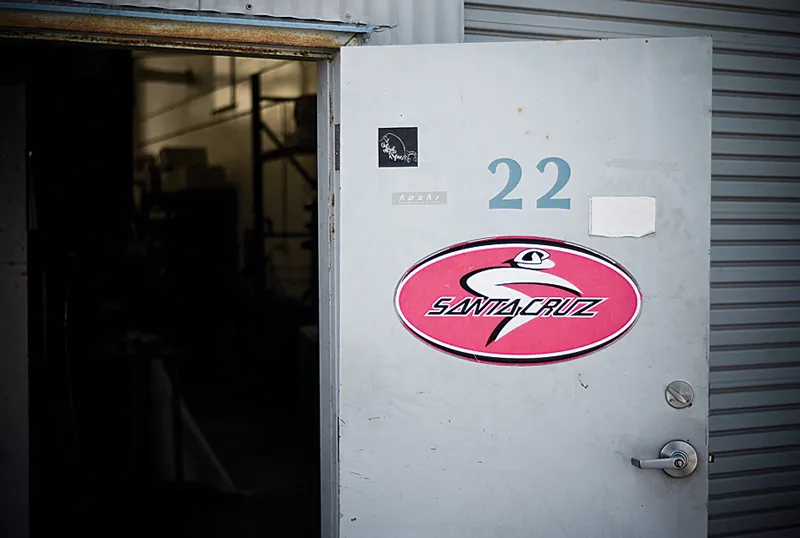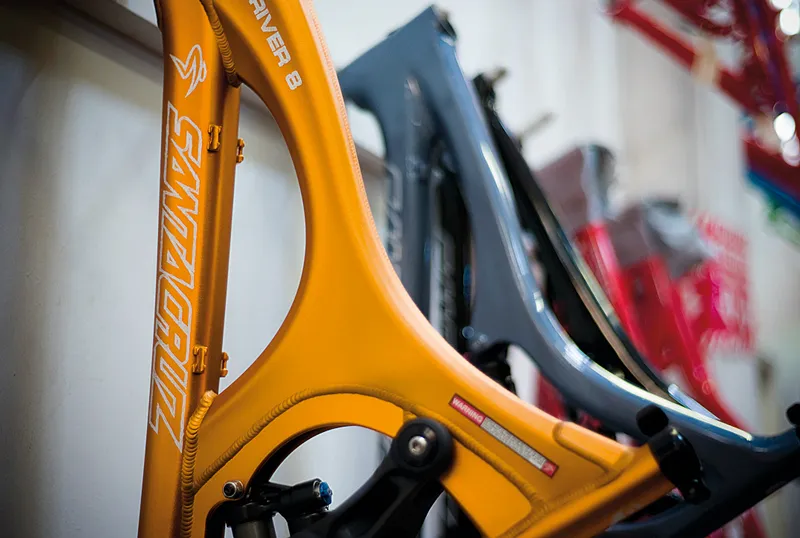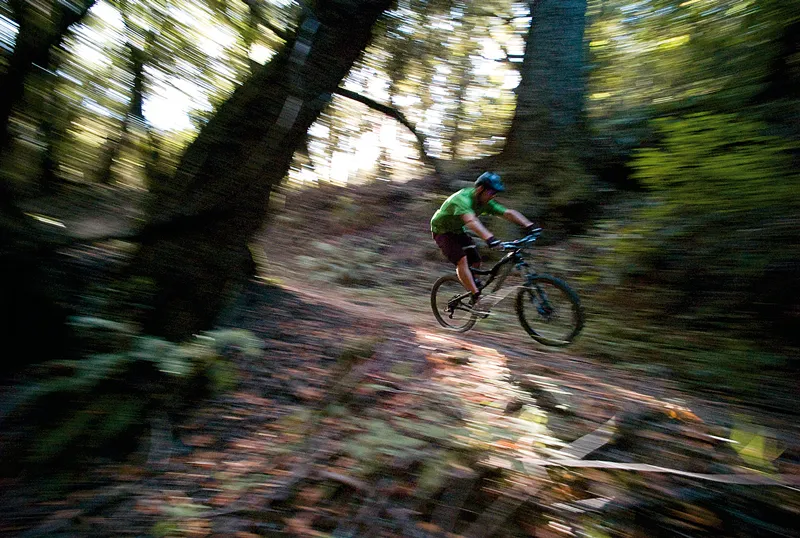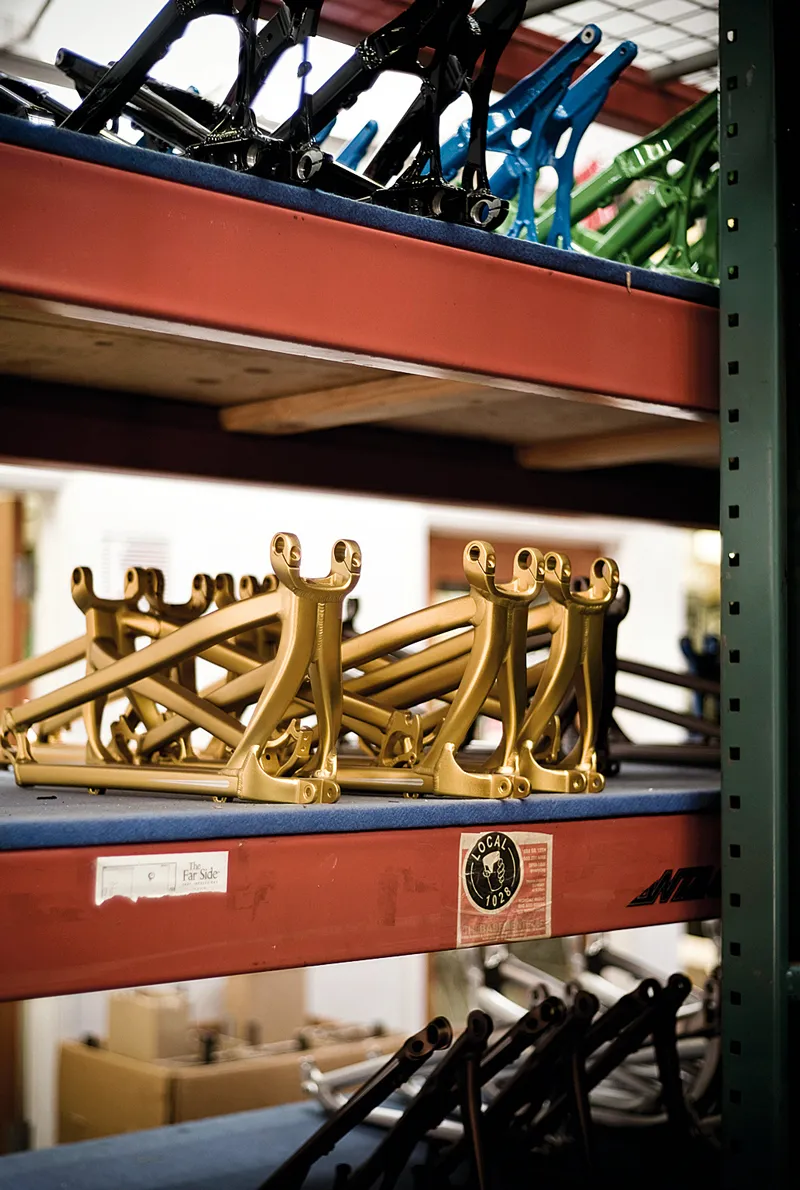Right now, I’m halfway through a furious ride with Rob Roskopp, co-founder and owner of Santa Cruz Bicycles. I’m also trying to catch my breath. For the past hour, I’ve watched Rob kick up the back end of his Blur LT Carbon as he airs the rolling jumps that punctuate our singletrack loop.
He’s yawning – the price to be paid after a night out with Steve Peat – but his riding suggests he’s anything but tired. I get the impression Rob has an almost inexhaustible reserve of energy for all things bike. Not bad for a man 47 years young.
Bikes haven’t always been Rob’s scene, though – he spent six years as a pro skater in the ’80s before launching Santa Cruz Bicycles. Since then, he’s built a brand with one of the strongest identities and most loyal fanbases around. It hasn’t happened by chance.
So what’s his secret? Rob is thickset, which, along with his shaved head, gives him the look of an East End bouncer rather than the boss of an innovative bike company. However, there’s a glint in his eye that suggests he always has something up his sleeve.
Lured by the Californian attitude (and sunshine), Rob took the 2,400-mile bus ride from Ohio to Santa Cruz at the age of 19 with just $800 in his pocket. Within two years, Santa Cruz Skateboards – headed by Rich Novak – was producing a Roskopp pro-model deck, versions of which are suspended on the wall at one end of Santa Cruz’s bike warehouse.
When I ask if he still skates, Rob replies, “Only with my son, just a little. I’m kind of over it now.” Still, Rob’s immersion in skating did supply him with the ability to keep his finger on the pulse of emerging trends.
When Santa Cruz Bicycles launched in 1994, they did so not with a hardtail, as was the norm, but with an early full-suspension bike. It was called the Tazmon, a 3in-travel single-pivot design whose main girder-like swingarm looked decidedly Heath Robinson. But what prompted Rob to get into the bike biz?
“Rich [Novak] was my mentor,” he admits. “It was Rich’s idea to start a bike company. I got back into riding around 1987 on a GT Karakoram, but 1989 was when I started riding a lot. I got Rich into it too, and one day he said, ‘What do you think about doing Santa Cruz bikes?’ I did some research, looked at the market and full-suspension made the most sense.
“You could consider the skate industry as at the cutting edge back then in terms of marketing, hipness and cool factor. The bike industry was about 10 years behind in style,” he continues. I look at the exquisite Blur LT carbon I’m straddling – clearly things have changed.
I ask Rob about the perceived upmarket identity of Santa Cruz. “There’s been a change in the industry, especially for the image of high-end models as that’s where you’re going to make your money,” he explains. “Who wants to turn out junk? We make bikes we want to ride!” Those bikes, it turns out, are often full-sussers.
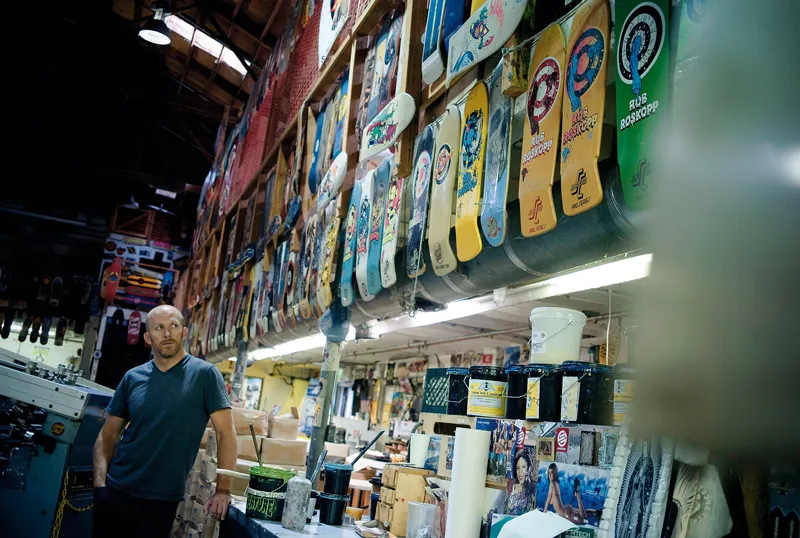
Santa Cruz are drenched in Rob’s history, as this wall of Roskopp skateboards testifies
Hanging loose
Indeed, despite the hills surrounding Santa Cruz being littered with fast singletrack that can be ridden on a cyclo-cross bike, a hardtail didn’t come to fruition until 1996. Even then the resulting Chameleon was designed to be a little different, with the ability to slot in a (then) long-travel fork or be converted to a singlespeed.
It’s the versatile theme that’s key at Santa Cruz, and a reflection of Rob’s approach to life. “I’ve done everything in this place, from sweeping the floors to looking after trade shows,” he grins, now glancing around the hotchpotch of tin-clad buildings that house his company.
There’s history here: the same premises once housed a fish cannery before becoming Keith Bontrager’s workshop, and Santa Cruz still shares this space with a commercial bakery. What was it like in the early days? “When the bike company started, I was screening T-shirts for Santa Cruz Skateboards,” he says wryly.
Proving ground
Although completely separate from the Santa Cruz skate brand except in name, dealers wrongly saw the company as jumping on the mountain bike bandwagon. So the bikes had to prove themselves. The Tazmon did just that and was followed a year later by the Heckler, a 4in-travel design that boosted sales three-fold, no doubt helped by its pivotal role in the groundbreaking freeride film Kranked.
Rob loves to push the performance of suspension design and Santa Cruz continued with almost annual increases in suspension travel as Rob kept ahead of the curve. While the Virtual Pivot Point (VPP) platform is popularly attributed to Santa Cruz, it was Rob’s curiosity and resourcefulness that led to Santa Cruz being the home of the VPP.
“Around 1999, I started looking for a suspension platform with better performance than the single pivot. We’re always trying to improve the ride, so I experimented on a couple of different platforms, figured out what I liked best and purchased the patents from James Klassen and Jamie Calon – who were the original inventors of VPP when it was on Outland Bikes. Outland folded around 1998,” he says.
This versatile, bob-free platform opened the possibilities for Rob’s designers, and the Blur XC was born, bringing with it a new fresh wave of cross-country orientated interest. Today, Santa Cruz only license the VPP to one other company: Intense Cycles.
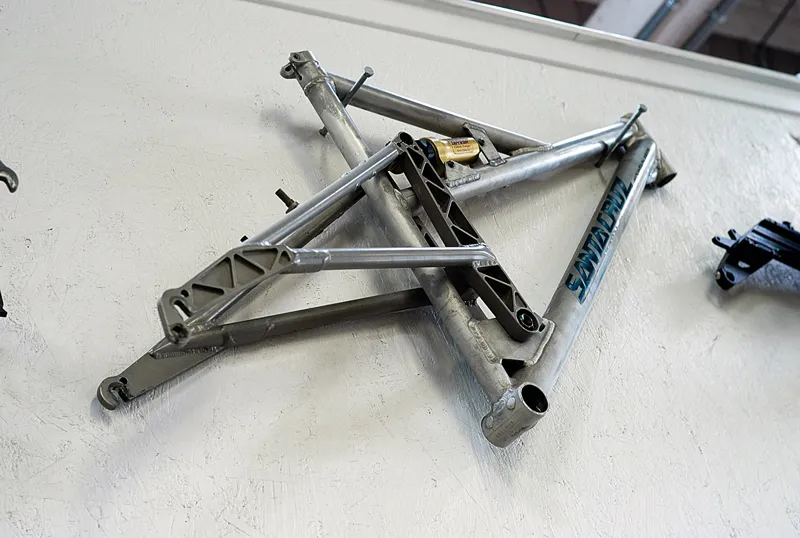
The Tazmon was Santa Cruz’s first frame, an unconventional full-susser based around a single-pivot design
A unique mind
With his versatile outlook, it’s hard to categorise Rob. He drives an Audi RS4 to and from a house he’s equipped with a battery of solar panels. Also, Santa Cruz still offer more than one suspension platform, which says a lot about the mind behind the company. Last year, they added two APP (Actual Pivot Point) bikes to complement their VPP and single-pivot offerings.
“We wanted to see how much difference the VPP shock rate would make by applying it to a single pivot. We were impressed, but we were so busy developing VPP, APP got shelved for years. Once we had time, we developed it further and received a patent in 2008 after waiting almost five years,” Rob explains.
Having started with the single pivot, Rob is keen to stress that this suspension platform will always be in the Santa Cruz line-up. He’s also happy to embrace the wave of carbon technology that’s sweeping the industry. When I ask him if the more recent carbon Blur XC and Blur LT Carbon were well received by the public, he’s confident.
“For the most part, yes,” he says, “because we’re not the first people to the [carbon] party. It’s funny, our first carbon prototype was made in 1995; we did a co-op deal with a local aerospace company, but the project never saw the light of day. So we’ve been thinking about carbon since almost day one."
"We now have an exclusive deal with our carbon manufacturer and are able to employ techniques others don’t, basically because it costs much more. We tested a lot of our competitors’ frames, at least the high-end carbon ones, and as a strength-to-weight ratio there’s nothing stronger right now,” he continues, giving me a peek at the rig they use to conduct 800lb shear tests on carbon seat tubes.
I shudder to think of how many of his competitors’ high-end frames have been reduced to splintered objets d’art at the hands of Rob. “We had to make our test rig bigger because it wouldn’t break our frames,” he says, pointing out another machine that drops 75lb gym weights onto frames for impact assessment.
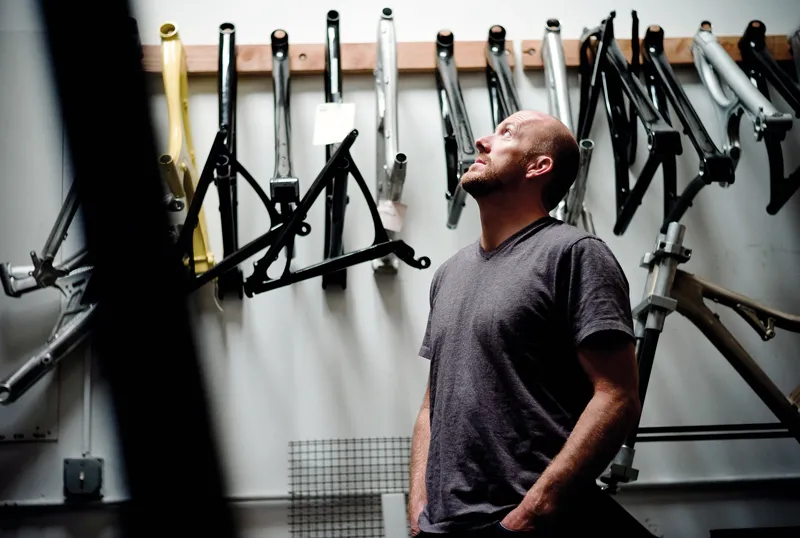
Rob passes a proprietorial eye over the fruits of his team’s hard labour
Trendsetter
Innovation has been key to the brand, spurred on by Rob’s own willingness to look beyond conventions and keep ahead of the trends. Frames are powder coated on site, allowing the company to offer the customer a customisable bike build. When Rob pushed for an online bike builder feature to be included on Santa Cruz’s website in ’98, the company were alone in doing so, save for two car firms.
As we pass through the powder-coating shop, I’m greeted by two smiling tattooed guys who have death metal blaring from speakers. They ooze ‘underground bike scene’. Outside the door, raw aluminium front triangles sit stacked next to sacks of flour destined for the industrial bakery unit next door, and it strikes me that Santa Cruz Bicycles don’t really jibe with the typical corporate image.
But that seems to be the way Rob likes it. When I ask how many bikes they ship each year, he’s quick to reply, “Performance, quality and service are what matter, not how many we make!” As I walk through stickered-up offices and past the Swobo warehouse (now part of Santa Cruz), it’s clear that it’s riding bikes that motivates the team to add the touches that make the brand so successful.
That and the podium places of the Santa Cruz Syndicate team riders Steve Peat, Josh Bryceland and Greg Minnaar, not to mention Cedric Gracia, who's also been on Santa Cruz bikes for the past year. When I ask how easy it was to get Peaty onto his team, Rob replies: “It certainly took some time but I'd been wanting to do it for a while,” hinting at the same ambition that's kept Santa Cruz ahead of the game.
As we grab a burger at a nearby grill, Rob fills me in on the other trails he’ll show me next time I visit. I laugh, admitting that much of what I saw this time around was his rear wheel kicking dust in my face. He smiles broadly and in an instant the person behind the East End bouncer facade is revealed: a regular bloke who isn’t afraid to seize opportunities, be they riding with a visiting photographer, or compiling one of the most revered bike ranges on offer today.
I ask him what’s in the pipeline for the future. “We’re always working on something new,” he answers, “and we’ll continue to make great products that put a big smile on my face!”
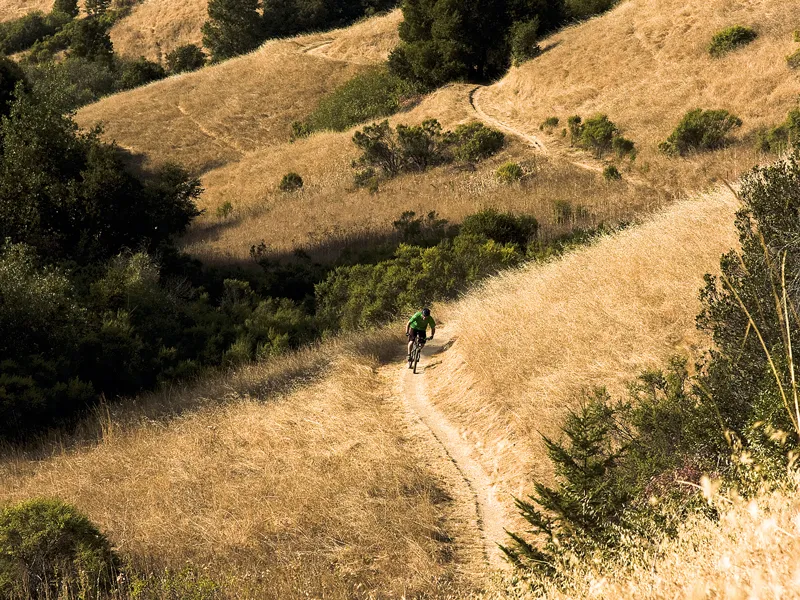
The glorious sun-drenched buff trails of California are Rob’s playground
Timeline
- 1982: Rob Roskopp, 19, leaves his home in Ohio for Santa Cruz, California. He goes with $800 on him and the idea of attending school there.
- 1983: School never gets a look-in. Instead Rob ends up being sponsored by Independent Trucks as a pro skater.
- 1984-90: Rob’s a skateboarder with his own pro model deck that’s made by Santa Cruz Skateboards. Rob gets into mountain biking on his GT Karakoram.
- 1990: Rob quits pro skating in order to return to school to study business.
- 1992: Rob gets married to Lepa.
- 1993: Working part-time at Santa Cruz Skateboards, Rob leaves night school to start Santa Cruz Bicycles along with co-founder Rich Novak.
- 1994: Santa Cruz launch their first bike onto the market – the 3in-travel full-sus Tazmon.
- 1995: Santa Cruz follow up with the esteemed Heckler, a 4in-travel full-susser.
- 1995: Cliff drops and gnarl in the first Kranked movie put the Heckler firmly on the freeride map.
- 1996: Rob releases the Super 8, an 8in-travel downhill race bike.
- 1998: Santa Cruz launch the Bullit, their first dedicated freeride bike, which uses a single-pivot suspension design.
- 1999: Rob sees the limitations of single-pivot designs and his designer advises him to seek out the VPP platform. Rob buys the VPP patent from Outland Cycles, who have gone bust.
- 2001: The 4in-travel Blur and 10in-travel V10 are launched simultaneously to show off the versatility of VPP. They’re both instant successes.
- 2005: Rob signs legendary rider Steve Peat to join his muscle team, the Santa Cruz Syndicate.
- 2009: Santa Cruz embrace the second wave of carbon technology to produce a carbon Blur XC. Four months later they release the Blur LT Carbon, a 140mm trail bike.
- 2010: Santa Cruz launch the APP platform, adding a swinglink to drive the shock on two new bikes: the 5in- and 6in-travel Nickel and Butcher. Peat, Minnaar and Bryceland ride the Fort William World Cup on carbon V-10 bikes.

